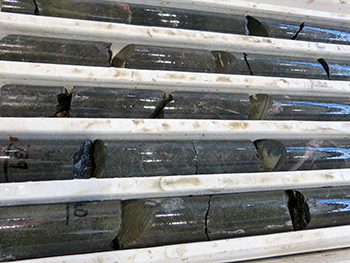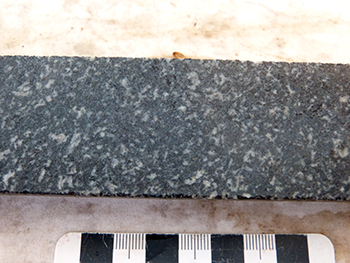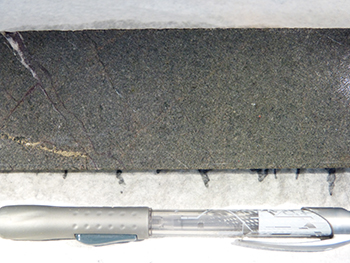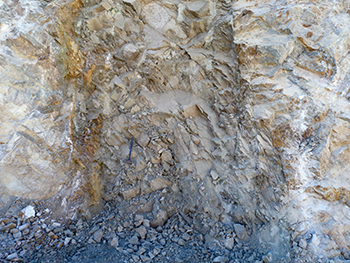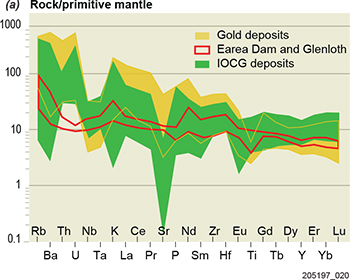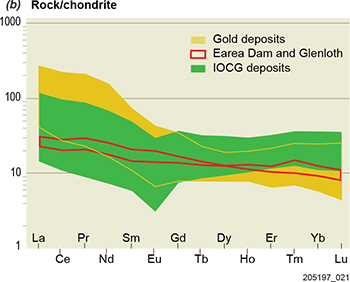Claire Wade1, 2, Anthony Reid1, 2, Justin Payne3 and Karin Barovich2
1 Geological Survey of South Australia, Department for Energy and Mining
2 School of Physical Sciences, University of Adelaide
3 School of Natural and Built Environments, University of South Australia
Download this article as a PDF (2.5 MB); cite as MESA Journal 90, pages 42–47
Published August 2019
Introduction
A coherent and related system of Mesoproterozoic magmatism, hydrothermal alteration and deformation extends from the western Gawler Craton to eastern Curnamona Province, South Australia. This system produced the Olympic Dam iron oxide – copper–gold (IOCG) orebody and the Olympic Cu–Au Province metallogenic system in addition to gold-dominant deposits of the Central Gawler Gold Province and related prospects across the Gawler Craton and Curnamona Province (Budd and Skirrow 2007; Skirrow et al. 2018; Reid 2019). Such an extensive system requires the input of an enormous amount of energy, and energy on such a scale can only be delivered into the crust from the mantle. Therefore, understanding the composition and evolution of the mantle lithosphere beneath the Gawler Craton is a key component towards understanding the evolution of the Mesoproterozoic mineral systems in this region.
Figure 1 Simplified solid geology location diagram of the study area within the Gawler Craton showing the sample locations in this study.
Recently we have been working on a major new geochemical and isotopic dataset that focuses on the mafic rocks of the Gawler Craton. This dataset includes 132 surface and drill core samples from across the Gawler Craton (Fig. 1). For each sample we have analysed the whole-rock major and trace element geochemistry. Selected samples have also been analysed for Sm–Nd isotopic composition. This dataset has now been published and fully described (Wade et al. 2019). In this paper we describe the major patterns evident in the new dataset in relation to a subset of samples associated with IOCG and gold mineral deposits and prospects. We also discuss the implications of the recognition of compositional heterogeneity and evidence for metasomatism in the source regions for the Mesoproterozoic mafic rocks of the Gawler Craton. We conclude that the IOCG and related mineral systems were fundamentally influenced by the mantle composition in terms of both its ability to melt and the magmas and metals thus released during this melting event.
Mafic geochemistry dataset: samples and methods
Mafic rocks provide a window into the lower crust and mantle as they are most often the product of melting of these source regions. In particular, when geochemical data are filtered to exclude samples that have undergone crustal assimilation during magma ascent and evolution, the geochemistry of primitive mafic rocks is indicative of the type of mantle from which they were derived (Walter 2014).
The new mafic rock dataset of 132 samples were selected from IOCG and gold-dominated deposits and prospects. Samples representative of the IOCG prospects include gabbros and aphanitic mafic dykes from drill cores located in the vicinity of Olympic Dam and Chianti prospect (Fig. 2a), samples from the White Hill region (Fig. 2b), and samples from the Hillside deposit (Fig. 2c). Samples that were taken from prospects related to gold mineralisation include mafic dykes collected from the region around Tarcoola, including from the Perseverance Mine (Fig. 2d), and also from several gold prospects across the Central Gawler Gold Province.
Geochemical analyses were performed by Bureau Veritas Minerals, Perth, Western Australia. Major elements and chlorine were analysed using X-ray fluorescence (XRF) spectrometry, while trace elements were determined by laser ablation - inductively coupled plasma - mass spectrometry (LA-ICP-MS) and Au, Pt and Pd were analysed using fire assay ICP-MS. FeO was determined volumetrically and fluorine was determined using specific ion electrode. Whole-rock analyses for Sm–Nd isotopic compositions were performed at the University of Adelaide.
Figure 2 Representative mafic rocks from the Hiltaba Suite.
2(a) Aphanitic basaltic dyke with quartz veining, 740.65–767.75 m, drillhole MGD 46 (SA Geodata drillhole number 229981), Chianti prospect. (Photo 417827)
2(c) Plagioclase–quartz–biotite–hornblende–chlorite diorite, with pervasive calcite, quartz, biotite and pyrite filled veins, 344.85–345.45 m, drillhole HDD117, Hillside deposit. (Photo 417829)
Summary of results
Figure 3 Major element and trace element variation diagrams vs Mg#, and εNd(1590 Ma) vs SiO2 for mafic Hiltaba Suite dykes associated with gold and IOCG deposits. Includes geochemical data from Budd (2006) and Frost (2009).
Of the 132 analysed, a subset of 50 samples from gold deposits Barns, Baggy Green, Earea Dam, Glenloth and Tarcoola, and IOCG deposits Chianti, Hillside and White Hill (Fig. 1) were used to compare geochemical and isotopic compositions of mafic rocks related to the different mineralisation styles. Silica values are low to intermediate, 42.7–61.8 wt% SiO2 (Fig. 3a), and Mg# (calculated as molar Mg# = (Mg/ [Mg+Fe] x100)) range from 25 to 67. In general, the gold deposit samples have higher Mg# (34–67) compared with the IOCG deposit samples (25–49). Coherent trends are formed between Fe2O3t and TiO2 with Mg# in the IOCG samples, while the gold samples have lower Fe2O3t and TiO2 abundances and form flatter trends, with the exception of samples from Earea Dam and Glenloth (Figs 3b, c). Ni, Th and Cr (not shown) contents are highest in the Barns samples and form coherent trends with Mg# (Figs 3d, e).
Three clear groupings have emerged from the data (Figs 3, 4). The samples from the IOCG province have moderate to high Cr and Ni; are generally enriched in high field strength elements including Zr, Nb, Th and Y (Fig. 4a); and have moderate light rare earth element enrichment (Fig. 4b). Samples associated with gold deposits or prospects have moderate to high Cr and Ni contents, are enriched in high field strength elements and have steeper rare earth element profiles than those of the IOCG province (Fig. 4b).
Distinct from these two groupings are a series of samples from the central Gawler Craton in the vicinity of the Earea Dam and Glenloth goldfields. These samples have generally low Cr and Ni (Fig. 3d), only moderate to low enrichment in the high field strength elements (Fig. 4a) and generally low light rare earth element content with a corresponding relatively flat rare earth element profile (Fig. 4b). In addition, these samples lack negative Nb–Ta–Ti anomalies in comparison to the pronounced Nb–Ta–Ti anomalies that samples from both the IOCG and gold-dominated regions have (Fig. 4a).
Sm–Nd isotopic compositions are also variable between regions, with the samples from the IOCG system being generally the most evolved, while those from the gold deposits are the least evolved (Fig. 3f). Samples from the Earea Dam and Glenloth region have moderately juvenile εNd(1590 Ma) values (Fig. 3f).
4(a) Primitive mantle normalised trace element diagram for mafic Hiltaba Suite dykes associated with gold and IOCG deposits.
Discussion: mantle metasomatism and mineral systems
Figure 5 Th/Nb vs TiO2/Yb plot of Pearce, Ernst and Peate (2015) showing different mantle source regions and the association of mafic Hiltaba Suite dykes correlated with gold and IOCG deposits in a subduction-modified lithosphere.
In general, the mafic component of the Hiltaba Suite is enriched in light rare earth elements and high field strength elements, has variable Nd compositions, and Th/Nb ratios >0.25. These characteristics are consistent with a subcontinental lithospheric mantle source region that was modified by subduction processes and was therefore hydrated, or partly hydrated mantle (Fig. 5; e.g. Goodenough, Upton and Ellam 2002; Sandeman, Cousens and Hemmingway 2003; Cai et al. 2013; Pearce, Ernst and Peate 2015; and Condie and Shearer 2017). This subduction-modified source is evident across most of the Hiltaba Suite and includes samples from both the IOCG district (Hillside, White Hill and Chianti) as well as from gold deposits (Barns, Baggy Green and Tarcoola).
Mantle input from c. 1590 Ma magmatic rocks is considered to be important for metals in the Olympic Dam Cu–Au Province and the Central Gawler Gold Province, as evidenced by the association of juvenile isotopes with increasing Cu and Au abundance (Budd and Skirrow 2007; Skirrow et al. 2007). Our new data suggest that a metasomatised, subduction-modified subcontinental lithospheric mantle is the most prominent geochemical group and appears to be associated with both IOCG and gold-dominated mineralisation styles.
Figure 6 Conceptual model for the formation of c. 1590 Ma Gawler Craton Au and IOCG mineral systems.
1 Multiple previous metasomatic events create siderophile and chalcophile-rich zones or veins in the SCLM.
2 Upwelling asthenospheric mantle and a mantle plume invoke partial melting of metasomatised SCLM and SCLM respectively.
3 Subsequently hydrous and fertile magmas (mafic Hiltaba Suite) are produced by such partial melting.
4 Au and Cu stored in the SCLM are remobilised by mafic magmas of the Hiltaba Suite.
5 Formation of Au and IOCG mineral deposits in upper crust.
Subduction and metasomatism have been recognised as being important processes to generate metal enrichment in the mantle (Richards 2009; Groves et al. 2010; Tassara et al. 2017), resulting in residual siderophile and chalcophile-rich zones or veins in the subcontinental lithospheric mantle. These zones or veins may constitute a viable source for Cu and Au, which are able to be remobilised by fertile and hydrous magmas (e.g. Hiltaba Suite) during partial melting of the subcontinental lithospheric mantle (Fig. 6). Generation of the IOCG and gold-dominated mineralisation in the Gawler Craton may be related to remelting of such a long-lived, subduction-modified metasomatised subcontinental lithospheric mantle (Fig. 6).
In contrast, the gold-related Earea Dam and Glenloth samples have low Th/Nb ratios (<0.10) and geochemical compositions consistent with an oceanic island basalt (OIB) source (Fig. 5). These samples may in fact represent a juvenile mantle source such as would be expected of a mantle plume (Paces and Bell 1989; Hart et al. 1992; Hastie et al. 2016). Although not as widespread or as strongly linked to economically significant mineralisation, the presence of these juvenile and OIB-like mafic rocks may be indicative of the occurrence of a mantle plume or lithospheric delamination event that may have affected the Gawler Craton (Skirrow et al. 2018). Such major geodynamic events could have been responsible for the melting of the pre-existing, subduction-modified subcontinental lithospheric mantle and the associated migration of metals and magmas into the crust to form the mineral deposits of the Gawler Craton.
Further work is underway to focus on determining metal sources by combining trace and rare earth element chemistry of minerals and in situ mineral isotope analysis to assess magma petrogenesis and an indicator of magmatic potential to contribute to deposit formation in the Gawler Craton.
Acknowledgements
This research is a part of PhD project (C Wade) in the Source to Spectrum Australian Research Council Linkage Project (LP160100578) supported by the Geological Survey of South Australia, Fortescue Metals Group, Minotaur Exploration Ltd, Investigator Resources Ltd and Rex Minerals Ltd.
References
Budd A 2006. The Tarcoola Goldfield of the Central Gawler Gold Province, and the Hiltaba Association Granites, Gawler Craton, South Australia. PhD thesis, Australian National University, Canberra.
Budd AR and Skirrow RG 2007. The nature and origin of gold deposits of the Tarcoola Goldfield and implications for the Central Gawler Gold Province, South Australia. Economic Geology 102:1541–1563.
Cai Y-C, Fan H-R, Santosh M, Liu X, Hu F-F, Yang K-F, Lan T-G, Yang Y-H and Liu Y 2013. Evolution of the lithospheric mantle beneath the southeastern North China Craton: constraints from mafic dikes in the Jiaobei terrain. Gondwana Research 24:601–621.
Condie KC and Shearer CK 2017. Tracking the evolution of mantle sources with incompatible element ratios in stagnant-lid and plate-tectonic planets. Geochimica et Cosmochimica Acta 213:47–62.
Frost A 2009. Petrogenesis, modelling and characterisation of layered mafic intrusions White Hill and Peculiar Knob North within the Mount Woods Inlier, South Australia. Hons thesis, Macquarie University, Sydney.
Goodenough KM, Upton BGJ and Ellam RM 2002. Long-term memory of subduction processes in the lithospheric mantle: evidence from the geochemistry of basic dykes in the Gardar Province of South Greenland. Journal of the Geological Society 159:705–714.
Groves DI, Bierlein FP, Meinert LD and Hitzman MW 2010. Iron oxide copper-gold (IOCG) deposits through earth history: implications for origin, lithospheric setting, and distinction from other epigenetic iron oxide deposits. Economic Geology 105:641–654.
Hart SR, Hauri EH, Oschmann LA and Whitehead JA 1992. Mantle plumes and entrainment: isotopic evidence. Science 256:517–520.
Hastie AR, Fitton JG, Kerr AC, McDonald I, Schwindrofska A and Hoernle K 2016. The composition of mantle plumes and the deep earth. Earth and Planetary Science Letters 444:13–25.
Paces JB and Bell K 1989. Non-depleted sub-continental mantle beneath the Superior Province of the Canadian Shield: Nd-Sr isotopic and trace element evidence from midcontinent rift basalts. Geochimica et Cosmochimica Acta 53:2023–2035.
Pearce JA, Ernst RE and Peate DW 2015. A geochemical proxy approach to LIP forensics. Abstracts - Geological Association of Canada 38.
Richards JP 2009. Postsubduction porphyry Cu-Au and epithermal Au deposits: products of remelting of subduction-modified lithosphere. Geology 37:247–250.
Sandeman HA, Cousens BL and Hemmingway CJ 2003. Continental tholeiitic mafic rocks of the Paleoproterozoic Hurwitz Group, Central Hearne sub-domain, Nunavut: insight into the evolution of the Hearne sub-continental lithosphere. Canadian Journal of Earth Sciences 40:1219–1237.
Skirrow R, van der Wielen SE, Champion DC, Czarnota K and Thiel S 2018. Lithospheric architecture and mantle metasomatism linked to iron-oxide Cu-Au ore formation: multidisciplinary evidence from the Olympic Dam region, South Australia. Geochemistry, Geophysics, Geosystems 19.
Skirrow RG, Bastrakov E, Barovich K, Fraser G, Fanning CM, Creaser R and Davidson G 2007. Timing of iron oxide Cu-Au-(U) hydrothermal activity and Nd isotope constraints on metal sources in the Gawler Craton, South Australia. Economic Geology 102:1441–1470.
Tassara S, González-Jiménez JM, Reich M, Schilling ME, Morata D, Begg G, Saunders E, Griffin WL, O'Reilly SY, Grégoire M, Barra F and Corgne A 2017. Plume-subduction interaction forms large auriferous provinces. Nature communications 8:843–843.
Wade CE, Payne JL, Barovich KM and Reid AJ 2019. Heterogeneity of the sub-continental lithospheric mantle and ‘non-juvenile’ mantle additions to a Proterozoic silicic large igneous province. Lithos 340-341:87–107.
Walter MJ 2014. 3.10 - Melt extraction and compositional variability in mantle lithosphere. In HD Holland and KK Turekian eds, Treatise on geochemistry. 2nd edn. Elsevier, pp. 393–419.



